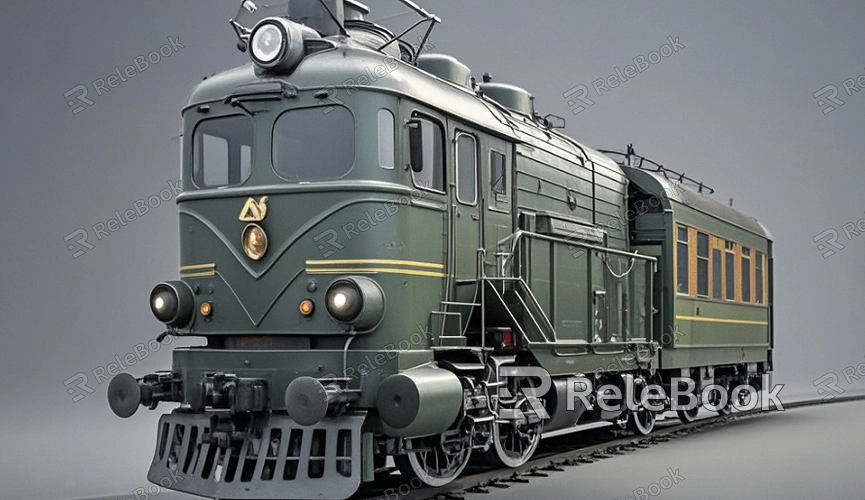How to 3D Model a Train?
Trains, as significant modes of transportation, offer rich materials for modeling due to their unique shapes and structures. Mastering training in 3D modeling not only enhances individual skills but also provides great convenience for related projects. This article will detail the steps and techniques involved in 3D modeling trains, helping readers understand how to transform their ideas into tangible models.

Understand the Basic Structure of Trains
Before starting the modeling process, it's essential to understand the basic structure of trains. A train typically consists of a locomotive, passenger cars, wheels, and tracks. The locomotive is the front end of the train, usually featuring a streamlined design to improve aerodynamic performance. The passenger cars vary in style, from simple flat-topped cars to luxurious coaches. The wheels' design must consider aesthetics as well as their interaction with the tracks.
At this stage, collecting images and technical information about trains is vital for deepening your understanding of different train types. This will provide the necessary references for the modeling process.
Choose the Right Modeling Software
Selecting suitable 3D modeling software is crucial for successful modeling. Numerous options are available, such as Blender, Maya, and 3ds Max. Each software has its own unique features and operating methods, so users can choose based on their needs and familiarity.
For example, Blender is an open-source software that’s great for users on a budget and offers a wealth of online tutorials. Maya and 3ds Max are more suited for professional users, boasting powerful animation and rendering capabilities. When choosing software, consider the following points:
User-Friendliness: A user-friendly interface can significantly reduce the learning curve.
Feature Richness: Whether it supports various modeling techniques like polygon modeling and surface modeling.
Community Support: An active community can provide ample learning resources and technical support.

Create the Base Model
Once the software is chosen, you can start creating the base model of the train. Begin with simple geometric shapes, like cubes and cylinders. These shapes can serve as the foundation for different parts of the train.
Locomotive: Use a cube as a base and gradually adjust its shape to create the streamlined appearance of the locomotive.
Passenger Cars: You can stack multiple cubes to form the passenger cars and then stretch and scale them to add details.
Wheels: Create the wheels using cylinders, adjusting their diameter and width to fit different train types.
Continuously check and adjust the model throughout this process to ensure that proportions are balanced and shapes are accurate.
Add Details
After completing the base model, you can begin adding details. The level of detail significantly impacts the model's realism. Consider the following aspects:
Windows and Doors: Create windows and doors by cutting holes or adding small geometries, paying attention to proportions and placement.
Wheel Details: Add bolts, tire textures, and other details to the wheels to enhance realism.
Textures and Materials: Apply appropriate textures and materials to different parts, such as metallic finishes and paint schemes for the cars.
This step requires skillfully utilizing the software's material editor to achieve the desired effects.
Rendering and Exporting
After completing the modeling and detailing, the final step is rendering and exporting. Rendering converts the 3D model into a 2D image and often involves adjusting lighting, shadows, and reflections. Choose an appropriate rendering engine and adjust the light source's position and intensity for the best outcome.
When exporting the model, select a file format that suits your project needs. Common formats like OBJ and FBX can be recognized by most engines and software. Ensure that necessary texture information is included for accurate display in subsequent uses.
3D modeling a train is a creative and challenging process, requiring patience and skill at every step, from base modeling to detailing. By deeply understanding the structure of trains, choosing the right software, and meticulously rendering, you can create realistic and captivating train models. If you're looking to further expand your 3D modeling projects, visit Relebook to download more exciting 3D models and textures.
FAQ
What kind of computer configuration do I need for 3D modeling?
3D modeling generally requires a high-performance computer, especially regarding graphics cards and memory. It's advisable to use a computer with a powerful graphics card to ensure the smooth operation of modeling software.
Which modeling software should beginners start with?
Blender is a great choice due to its powerful features and free availability. Beginners can quickly get started through a wealth of online tutorials.
How can I improve my modeling skills?
Practice is key to improving modeling skills. Try mimicking existing models, taking online courses, or joining modeling communities for feedback.
Where can I find inspiration for train modeling?
You can gain inspiration by exploring related books, websites, and social media art. Observing actual trains is also a great way to gather ideas.
After completing a model, how do I handle animations?
Most modeling software includes built-in animation features. You can create animations by setting keyframes and using a rigging system for the model.

